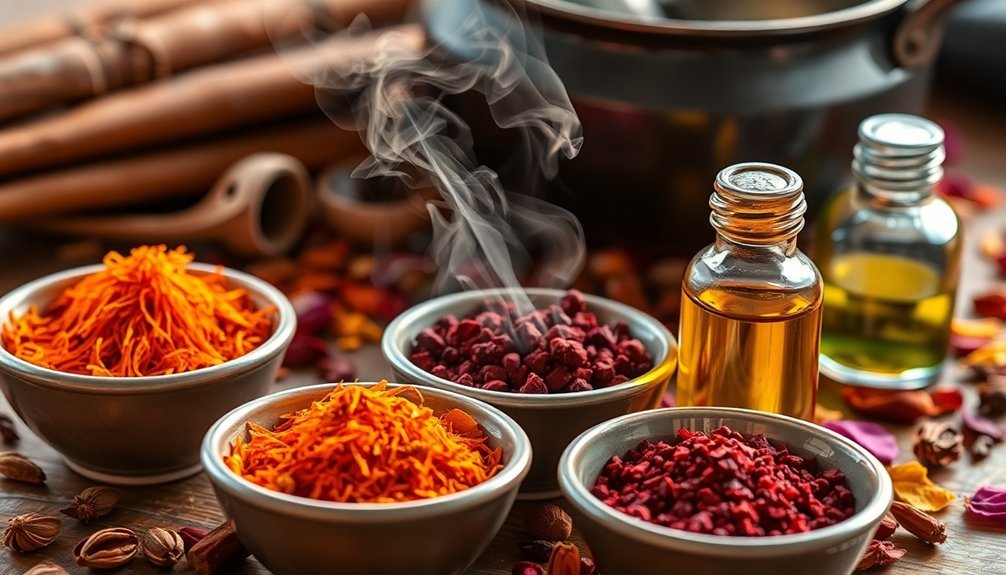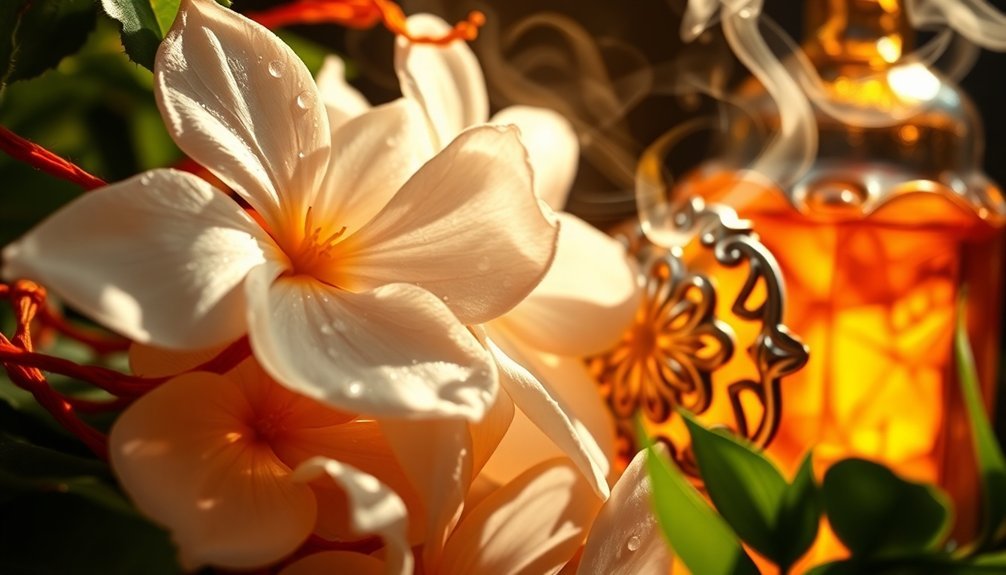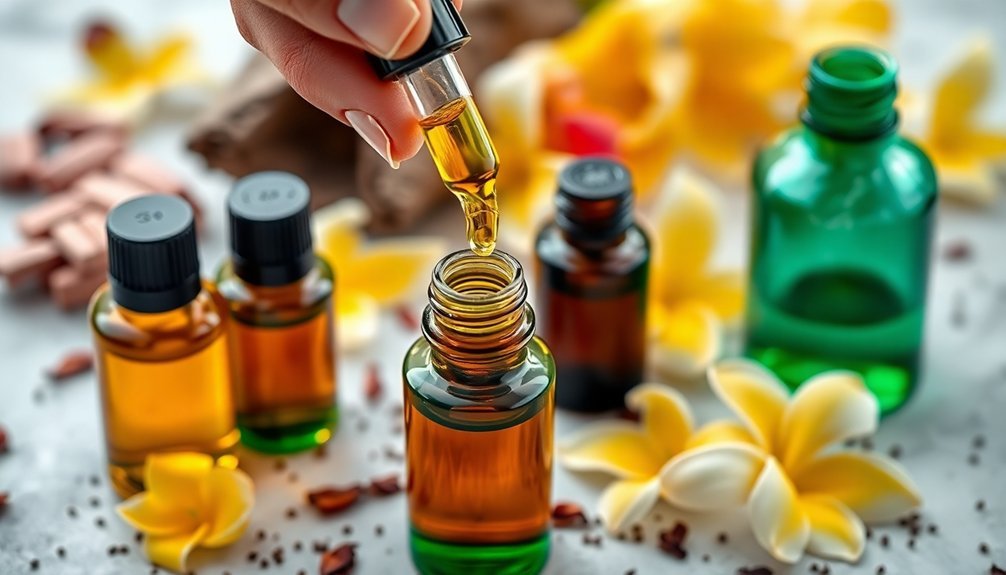Create exotic oriental fragrances by following the 30:50:20 ratio for top, middle, and base notes. You'll want to blend precious ingredients like vanilla, myrrh, and patchouli (keeping strong elements under 5%), while incorporating spices such as cardamom and cinnamon for depth. Layer your scents carefully and store them in dark glass bottles at 15-25°C for ideal aging. The ancient art of oriental perfumery holds many more aromatic secrets waiting to be discovered.
Understanding the Soul of Oriental Fragrances

When you explore the world of Oriental fragrances, you'll discover an enchanting blend of warmth, sensuality, and cultural heritage that spans centuries.
These luxurious scents are rooted in Middle Eastern and Asian traditions, offering sophisticated profiles that shine during evening events and winter months. A harmonious combination of rich exotic notes creates an unforgettable aroma signature.
You'll find Oriental fragrances built on a foundation of precious ingredients like vanilla, amber, and exotic spices.
They're masterfully crafted to create long-lasting impressions through complex interactions with your skin chemistry.
Whether you prefer the delicate touch of soft Orientals with their floral-spicy core or the bold intensity of traditional blends like Shalimar, there's a perfect match for your style.
Each fragrance tells a unique story through carefully balanced top, middle, and base notes, delivering an intimate experience that's both personal and profound.
Essential Base Notes for Oriental Blends
The foundation of any Oriental fragrance lies in its carefully selected base notes, which provide depth, longevity, and character to the overall blend. You'll find rich ingredients like vanilla, myrrh, and frankincense creating the signature warmth that defines these exotic scents. These base notes have varying volatility rates that affect how long the scent will last on your skin.
| Base Note | Key Characteristic |
|---|---|
| Patchouli | Earthy depth & intensity |
| Benzoin | Long-lasting fixative |
| Sandalwood | Sweet woody undertones |
| Labdanum | Rich complex layers |
When creating your blend, remember to follow the 30:50:20 ratio for top, middle, and base notes. Strong ingredients like myrrh and patchouli shouldn't exceed 5% of your total blend. You'll want to experiment with combinations of tonka bean, vanillin, and coumarin to achieve that perfect oriental accord, while resins like styrax and opopanax add essential warmth and complexity.
Mastering the Art of Layering Spices

Mastering spice layering in oriental fragrances requires a deep understanding of how different aromatic elements interact and complement each other.
Start by applying your fragrances to clean, moisturized skin, focusing on pulse points where body heat will naturally amplify the scents.
You'll want to begin with lighter notes before moving to heavier ones. Apply citrus or fresh scents first, followed by your spicy middle notes like cardamom or ginger. Oriental fragrances create incredible depth when paired with vanilla for warmth. Ground these with a warm base note such as sandalwood or musk.
Don't rub the fragrances – let them develop naturally on your skin.
For longer-lasting results, use unscented lotion as your foundation. Consider matching body products to enhance the overall effect.
Remember to test your combinations on paper strips first to guarantee your chosen spices create a harmonious blend.
Achieving the Perfect Resin Balance
Creating a harmonious resin balance demands precise measurements and an intimate knowledge of each resin's unique characteristics. You'll find that resins like frankincense, myrrh, and benzoin act as powerful base notes, anchoring your oriental blend while providing essential fixative properties.
| Resin Type | Best Pairings | Aging Time |
|---|---|---|
| Frankincense | Citrus, Spice | 3-6 months |
| Myrrh | Woods, Vanilla | 4-8 months |
| Benzoin | Florals, Amber | 2-4 months |
| Labdanum | Oriental, Musk | 3-5 months |
To achieve ideal results, store your resinous blends in dark glass bottles and age them in a cool, dry place. When combining resins, start with small quantities and gradually build your composition. Remember to test your blend periodically on scent strips to monitor its evolution and make necessary adjustments to achieve the perfect oriental signature.
Floral Notes That Enhance Oriental Magic

Skillfully incorporating floral notes into oriental fragrances can transform your blend from mysterious to magical. You'll find jasmine to be an essential player, adding sensuality while harmonizing perfectly with vanilla and cinnamon notes.
To create depth and sophistication, you can layer iris and orchid notes into your composition. They'll introduce powdery sweetness and exotic elements that enhance the fragrance's complexity.
For a fresh twist, consider orange blossom, which provides an airy contrast to deeper oriental bases while working beautifully with spicy elements.
Don't overlook gardenia and honeysuckle when crafting your blend. These flowers bring sweet undertones that balance resinous notes expertly.
You'll notice how they contribute to the indulgent character of fragrances like Organza by Givenchy, making them perfect choices for evening and winter scents.
Creating Signature Oriental-Gourmand Fusions
Beyond the allure of floral notes, oriental-gourmand fusions offer an exciting path to crafting unique signature scents. You'll find success by combining vanilla, tonka bean, and amber with delectable gourmand elements like caramel and creamy milk notes.
| Base Notes | Enhancers | Balancers |
|---|---|---|
| Vanilla | Spices | Sandalwood |
| Tonka Bean | Citrus | Patchouli |
| Amber | Florals | Cedar |
| Maple | Rum | Labdanum |
To create your perfect blend, start by analyzing the interaction between top, middle, and base notes. You'll want to balance sweetness with woody elements and incorporate spicy contrasts for depth. Test your creation thoroughly, making adjustments until you achieve the perfect harmony of warmth and complexity. Don't forget to personalize your blend by experimenting with different ratios and layering techniques.
Time-Tested Blending Ratios and Techniques

When crafting oriental fragrances, mastering time-tested blending ratios and techniques will elevate your perfume-making skills.
Start with the classic 30-50-20 ratio of top, middle, and base notes, or opt for a 20-30-50 split if you're creating more complex oriental blends.
Begin by measuring small amounts using drop counts for precision. You'll want to mix your chosen fragrances thoroughly in small cups, ensuring they're fully incorporated.
Test your creation on fragrance strips and let it mature for at least a week – this allows the chemicals to interact and develop a rounded scent profile.
Don't forget to clear your nose with coffee beans between tests to avoid sensory fatigue.
Keep detailed records of your combinations, and don't hesitate to adjust ratios based on how the fragrances interact on your skin.
Preserving and Aging Your Oriental Creations
Proper storage and aging techniques can transform your oriental fragrances from good to exceptional. Store your precious blends in dark glass bottles, preferably amber or cobalt blue, to protect against UV damage.
You'll want to keep them in a cool, dry space where temperatures stay between 15°C and 25°C.
Don't store your oriental creations in plastic containers or steamy bathrooms, as this can alter their complex notes. Instead, opt for airtight glass or stainless steel vessels that prevent oxidation.
When handling your blends, use clean tools and avoid excessive shaking. For longer-term storage, consider separating fragrances by scent family to prevent cross-contamination.
Remember to periodically uncap your bottles to release built-up pressure and allow the ingredients to settle properly, enhancing the aging process.
Frequently Asked Questions
Can Pregnant Women Safely Wear Oriental Fragrances Containing Oud and Heavy Resins?
You can wear oriental fragrances while pregnant, but test them first as they're potent and may trigger nausea or headaches. Choose phthalate-free options and limit use if you experience sensitivity symptoms.
How Do Skin Chemistry Differences Affect the Longevity of Oriental Perfumes?
Your unique body chemistry dramatically impacts how oriental fragrances develop. Your skin's pH, natural oils, and bacteria interact with rich resins and woods, making the scent last longer or fade faster on you.
Why Do Some Oriental Fragrances Smell Medicinal on Certain People?
Your skin chemistry and body temperature can react with oriental fragrance ingredients like amber and resins, creating medicinal notes. Your diet and metabolism also influence how these complex scents develop on your skin.
Does Altitude or Climate Affect the Projection of Oriental Fragrance Blends?
Yes, your oriental fragrances will project differently at varying altitudes. You'll notice stronger projection in warmer, humid climates, while high altitudes and cold, dry conditions will make the scent stay closer to your skin.
Can Oriental Fragrances Trigger Allergic Reactions More Than Other Perfume Families?
Yes, you're more likely to experience allergic reactions with oriental fragrances due to their higher concentration of common allergens like cinnamic compounds, balsam of Peru, and fragrance mixes compared to other perfume families.
In Summary
You've now mastered the fundamentals of oriental perfumery. With your knowledge of authentic spices, precious resins, and exotic florals, you'll create mesmerizing blends that tell their own stories. Don't be afraid to experiment beyond traditional ratios – your unique touch is what makes each creation special. Remember to give your blends time to mature, and you'll discover they become even more enchanting with age.
References
- https://fragrancepassion.us/blogs/the-world-of-perfume/the-oriental-olfactory-family
- https://sedralkhaleej.com/en/blogs/blog/best-oriental-ingredients-for-your-perfumes
- https://www.fragrenza.com/blogs/notes-in-perfumery/oriental-notes-in-perfumery
- https://www.scentopia-singapore.com/oriental-perfume-ingredients.html
- https://habibiny.com/blogs/article/what-i-wish-everyone-knew-about-oriental-fragrance
- https://www.perfumedirect.com/blogs/news/what-are-oriental-fragrances-how-to-choose-one
- https://parfumsnajmi.com/blogs/infos/exploring-the-science-behind-oriental-fragrances
- https://www.cranbourn.com/scents-botanicals/oriental-fragrance-family/
- https://www.myscentstories.com/perfumes/what-are-oriental-fragrances/
- https://parfumplusmag.com/uncategorised/the-fantastic-oriental-fragrances/





Leave a Reply